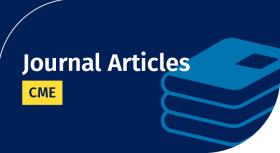
Progress in the Treatment of Pulmonary Hypertension Associated With Interstitial Lung Disease
Pulmonary hypertension, frequently complicating the course of patients with fibrotic interstitial lung disease, is associated with significantly increased morbidity and mortality. The availability of multiple medications to treat pulmonary arterial hypertension has resulted in these agents being used beyond their original indication, including in patients with interstitial lung disease.
Whether pulmonary hypertension in the context of interstitial lung disease is an adaptive response not to be treated or a maladaptive phenomenon amenable to therapy has been uncertain. Although some studies have suggested a benefit of treatment, there have been others demonstrating harm. This concise clinical review provides an overview of prior studies and the issues that have plagued drug development for a patient population in dire need of treatment options.
More recently, there has been a paradigm shift, with the largest study to date demonstrating benefit, resulting in the first approved therapy in the United States for patients with interstitial lung disease complicated by pulmonary hypertension. A pragmatic management algorithm in the context of changing definitions, comorbid contributors, and an available treatment option is provided, as are considerations for future clinical trials.
Target Audience
Pulmonologists, critical care specialists, translational researchers, and clinicians
Learning Objectives
At the conclusion of this activity, learners should be able to:
- Describe the need to screen for pulmonary hypertension in patients with ILD
- Recognize the impact of treating pulmonary hypertension associated with ILD
- Relate the importance of contributory comorbidities to the development of pulmonary hypertension in patients with fibrotic ILD
Accreditation Statement
The American Thoracic Society is accredited by the Accreditation Council for Continuing Medical Education to provide continuing medical education for physicians.
Disclosure Declaration
The current practice of the American Journal of Respiratory and Critical Care Medicine (AJRCCM) is to publish high quality, peer-reviewed and evidence-based original research, Concise Clinical Reviews, Guidelines and Consensus Statements. Articles published in AJRCCM include evidence-based summaries of optimal practice (Concise Clinical Reviews), evidence-based guidelines, workshop summaries and original contributions that will influence clinical practice. The publication of these articles by itself is only one piece of a multi-step process for the translation of evidence-based improvements in care to clinical practice. Articles selected for CME credit are designed to be the next step in the process of translating clinically relevant, evidence-based recommendations into clinical practice. This will be accomplished through a series of questions specifically designed by the author(s) to test that readers have the tools needed to translate recommendations for diagnostic and therapeutic clinical care into clinical practice. Members of the AJRCCM editorial board will review these questions and assess the quality of the questions based on:
- Clarity,
- Educational content, and
- The quality of the evidence supporting the response to the question. Posttest questions will assess if practitioners have understood the most important recommendations available for the diagnosis and treatment of pulmonary diseases, critical illness, and sleep disorders and are able to implement them into clinical practice.
Article Authorship Disclosures (as submitted to the ATS prior to article publication date)
Steven D. Nathan, M.D. (Inova Fairfax Hospital, Falls Church, VA, USA) has received consulting fees from United Therapeutics, Bellerophon, Third Pole, Merck, Roche, and Boehringer-Ingelheim. He has received payment or honoraria for lectures, presentations, speakers bureaus, manuscript writing, or educational events from United Therapeutics and Boehringer-Ingelheim. He has received payment for expert testimony from Roche. He has received support for attending meetings and/or travel from Ferrer and United Therapeutics.
Disclosures of AJRCCM CME Planners
Dr. Schenck reported that he is a consultant for Axle Informatics
Off-Label Usage Disclosure
Sildenafil for the treatment of pulmonary hypertension associated with fibrotic ILD
AJRCCM CME Planners
Edward Schenck, M.D.
Associate Editor, AJRCCM
To receive credit for this journal article:
- Read the journal article. Keep track of how long it takes you to read it.
- Once you open the article, the Post-Test becomes available. After reading the article, answer the post-test questions. You must answer all questions correctly to earn credit. You may take the test as many times as you like.
- Once you pass the Post-Test, the Evaluation becomes available. Answer all the evaluation questions.
- Once you complete the evaluation, select the amount of credit to receive based on the time it took you to read the article.
- You can view, save and print your Certificate by pressing the Certificate button.
- To review the credits you've earned in this system and reprint certificates, go to the My Learning drop-down list. Then select Transcript.
Available Credit
- 1.00 AMA PRA Category 1 Credit(s)™The American Thoracic Society designates this for a maximum of 1.00 AMA PRA Category 1 Credit(s)™. Physicians should claim only the credit commensurate with the extent of their participation in the activity.
- 1.00 Participation

 Facebook
Facebook X
X LinkedIn
LinkedIn Forward
Forward